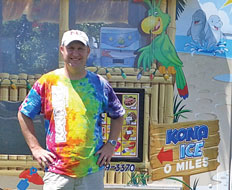Eric Wright signed on with Kona Ice, a shaved-ice concept, in 2009. His Kansas City–based business is mostly mobile and outdoor-oriented, consisting of food trucks, carts, and kiosks, and has become increasingly profitable despite sometimes less-than-ideal weather conditions.
Wright has focused on developing new stations that can go where his food trucks cannot, and he’s established connections with local schools and parks that ensure his warm-weather-based product is available year-round.
He explains how mobile concepts and other businesses that depend on warm, dry conditions can keep sales sunny even when the weather is not.
1. Pay attention to the weather early on
Weather is always a challenge, and it’s normally challenging when you don’t want it to be. For example, when I really want it to be in the 90s, let’s say on a Saturday, it’s raining.
Franchisees need to track the temperatures and their sales, especially when starting out. Additionally, try not to look at the drop in temperature with such disdain. For instance, as long as we keep a truck going and it’s above 60 degrees, we’re going to have a good business day. Now, obviously, when it’s a warmer day in the 80s, we’ll do 20 percent better in sales, but that doesn’t mean that the 60-degree day was bad.
Franchisees who have physical buildings have better days than others, and this type of quick serve is no different. It might be tough for some franchisees to accept, but if the weather has a big impact on business day to day, you might need to fix something else besides hoping for warmer days.
The moment the jackets unzip and the gloves are off, we’re selling. We had a food truck out at high-school football games last year, on a 45-degree day, and kids were still buying our product. If you’ve made a name for yourself, people will continue to seek you out.
2. Take the product indoors
Franchisees that have mobile concepts need to think about utilizing different avenues to move their product. We’re a year-round operation. The first winter, I shut down everything and locked it up. There were opportunities during the year that I might have had some profitable days, but it would have been outdone by the amount of work I had to put into it. In order to keep business going throughout the year, I decided to take the product indoors.
The kiosks and carts can go into buildings and serve kids that our food trucks might not be able to get into. Most of the time, we’ll set up the carts at high school basketball games or other school events. The situation gets even better when you find out that the schools usually have boosters signed on to work the event. We set it up, they run and operate it, and we both walk away with a profit. It’s a successful fundraiser for them and it’s business for you.
3. Rain or shine, don’t miss the opportunities
Starting out, I used to have mood swings on a daily basis when I felt the weather was going to turn. In the past, I would look at the 10-day forecast and it would always bum me out, but then, two days later, it would be completely different. Today, I’ll generally only look two days out in terms of conditions. The biggest thing is not missing potential opportunities when the weather is bad.
I didn’t actively pursue the business model I have today. When I first started, I knew a woman who was involved with a parent-teacher organization at a local school district. We signed on to work one of their carnivals, which would happen rain or shine. They mentioned it to another district and so on, leading to 85 percent of our business today in booked events.
Right now we do a lot of after-school camps with the YMCA. Every week we go and it doesn’t matter if it’s 50 and raining, the kids want us there, and so does the staff. I remember being so protective of the truck my first year and not wanting to go out in inclement conditions—big mistake. If we don’t show up, counselors get angry because they have to deal with angry kids who were promised a treat, which ultimately leads to lost business. Business can continue even during poor conditions.
4. Develop more mobility
The trucks are great. They have a certain presence that you might not get from other avenues, but there can be other means of generating business. Kona has portable kiosks that are acceptable means of distributing product. I developed the idea even further by making it a little sturdier of structure.
These kiosks are easier to maintain and uphold the daily volume that you would have at our desired locations, which in this case were water parks. The kiosk led the way to our cart system that can easily go inside schools and small buildings and houses two serving stations on the side. What’s even better is you can utilize the labor that’s already there. The trucks house my direct employees, but the carts and kiosks, most of the time, will have staff assigned to our brand.
On any given day, we could have a cart inside a school during a game, a kiosk open at a water park, and all five trucks out serving Kona Ice. The failsafe is that if it’s raining or cold, not all forms of business will be obsolete. We’ll have Kona somewhere serving.










